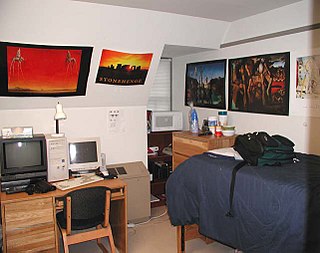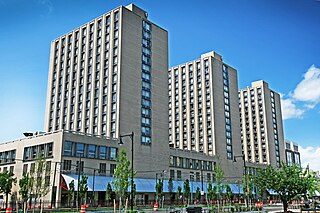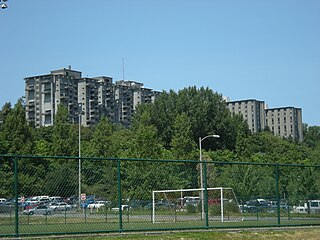
A dormitory, also known as a hall of residence or a residence hall, is a building primarily providing sleeping and residential quarters for large numbers of people such as boarding school, high school, college or university students. In some countries, it can also refer to a room containing several beds accommodating people.

Balch Hall is the only remaining all-female residence hall on the North Campus of Cornell University. Originally, Balch Hall consisted of four eighty-student halls, hence the more former name the Balch Halls, which has fallen out of use. Balch Hall is open only to female freshman and is divided into sections, known as units, each with a Residential Advisor who helps the new students acclimate themselves with the campus. Prior to the 2021-2024 renovations, the building was known for its old fashioned design as each room has a personal sink, or shares a sink with one other room.

The Boston University housing system is the 2nd-largest of any private university in the United States, with 76% of the undergraduate population living on campus. On-campus housing at BU is an unusually diverse melange, ranging from individual 19th-century brownstone town houses and apartment buildings acquired by the school to large-scale high-rises built in the 60s and 2000s.

The campus housing system at the University of Michigan in Ann Arbor, referred to as University Housing, provides living accommodations for approximately 10,000 undergraduate and graduate students. There is no requirement for first-year students to live in University Housing, yet approximately 97% of incoming students choose to do so. Every year, over 9,500 undergraduate students are housed in 18 residence halls on Central Campus, the Hill Neighborhood, and North Campus. Undergraduates, graduate students, and students with families can live in University Housing apartments in the Northwood Community on North Campus. Seven full-service dining halls as well as several retail shops provide students with daily dining options.

North Campus is a mostly residential section of Cornell University's main campus in Ithaca, New York. It includes the neighborhoods located north of Fall Creek. All freshmen are housed on North Campus as part of Cornell's common first-year experience and residential initiatives.

Mary Markley Hall (Markley) is a residence hall operated by the University of Michigan University Housing in Ann Arbor.

At the Massachusetts Institute of Technology (MIT), students are housed in eleven undergraduate dorms and nine graduate dorms. All undergraduate students are required to live in an MIT residence during their first year of study. Undergraduate dorms are usually divided into suites or floors, and usually have Graduate Resident Assistants (GRA), graduate students living among the undergraduates who help support student morale and social activities. Many MIT undergraduate dorms are known for their distinctive student cultures and traditions.

Morris A. Schapiro Hall, popularly known as Schapiro, is an undergraduate residence hall of Columbia University. The building is named after investment banker Morris Schapiro, who oversaw the merger of Chase Bank and Bank of Manhattan as well as the Chemical Bank and New York Trust Company.

Litchfield Towers, commonly referred to on campus as "Towers", is a complex of residence halls at the University of Pittsburgh's main campus in the Oakland neighborhood of Pittsburgh, Pennsylvania, United States. Litchfield Towers is both the largest and tallest residence hall at the University of Pittsburgh, housing approximately 1,850 students.

Lothrop Hall is a major student dormitory at the University of Pittsburgh's main campus in the Oakland neighborhood of Pittsburgh, Pennsylvania. Lothrop Hall is located adjacent to the University of Pittsburgh Medical Center (UPMC) on Lothrop Street near Fifth Avenue, this hill is often referred to as "cardiac hill" due to its steep grade and its accessibility to medical care. The Hall is made up of 14 floors, some of which are segregated by sex in each wing. Most rooms in the hall are single occupancy, with some double occupancy as well, and even some tripled on floors 2–10. The dorm houses 723 people, in addition to a resident director and 15 resident assistants.

Tietgenkollegiet, named for Danish financier C.F. Tietgen (1829-1901), is a student residence located in the Ørestad district of Copenhagen, Denmark.

Court–Kay–Bauer Community (CKB) is a group of freshman residence halls on Cornell University's North Campus opened to Cornell students in the fall of 2001. The building was first named Court Hall for the dormitory’s formation of a courtyard enclosed on the opposite side by Clara Dickson Hall. On October 14, 2005, the southern wing of Court Hall was renamed Bauer Hall in response to a gift of $10 million to the University by Robert and Virginia Bauer. On October 12, 2006, the middle wing of Court Hall was renamed Kay Hall, also in response to a donation of $10 million by Bill Kay. Court-Kay-Bauer Halls, as well Mews Hall, were built as a part of the North Campus Housing Initiative, and are being renamed in order to fund construction of new upper-classmen residence halls on Cornell’s West Campus. The money generated from the renaming of Court Hall has been put towards the estimated $248 million development of West Campus. Bauer Hall is the section south of the bridge, Kay Hall is the section north of the bridge, and Court Hall is the section perpendicular to Kay Hall.

Over 8,000 undergraduate and graduate students live in campus housing at the University of North Carolina at Chapel Hill during a regular school year. Forty residence halls are grouped into 16 residential communities across campus.

Housing at Georgetown University consists of 13 residence halls at the main campus and a law center campus. Housing on Georgetown's main campus is divided between "halls," usually more traditional dormitories, and "villages", usually less traditional apartment complexes. In addition, Georgetown operates many townhouses in the Georgetown neighborhood, usually for second, third, and fourth-year students.
Housing at the University of Georgia is managed by the Department of University Housing. On campus housing for undergraduate students is divided into ten communities, and for graduate students into three communities.

Flaherty Hall is one of the newest of the 32 Residence Halls on the campus of the University of Notre Dame and one of the 15 female dorms. It is located on Mod Quad, between Knott Hall and McCourtney Hall. Built in 2016 together with its twin dorm Dunne Hall, it was the first dorm built since Ryan Hall in 2009. The coat of arms is taken form the Flaherty family, with the bears replacing the Flaherty dragons.

Dunne Hall is one of the newest of the 32 Residence Halls on the campus of the University of Notre Dame and one of the 16 male dorms. It is located on East Quad, between Pasquerilla East Hall and Johnson Family Hall. Built in 2016 together with its twin dorm Flaherty Hall, it was the first dorm built since Ryan Hall in 2009.

Housing at the University of Washington is administered by the Housing & Food Services (HFS) department at the University of Washington. Undergraduates are housed primarily in residence halls located on North Campus and West Campus. Typically, residence halls are 9-month spaces for undergraduate students. However, there are also 12-month apartment spaces available for undergraduate students. Graduate and professional students are provided the option to live in 12-month apartments operated either by the university or privately. The University of Washington does not require students to live on campus. Although students are not required, about 71% of freshmen choose to live on campus. Housing is not guaranteed but placement in the residence halls is guaranteed for returning residents. Most winter quarter and spring quarter applicants are assigned housing. There are also three family housing options for registered full-time students at the Seattle campus.

The main campus of Temple University is in North Philadelphia about 1.5 miles (2.4 km) north of Center City. It occupies 118 acres (48 ha); an estimated 12,626 students live on or near it. Events for students and the public include concerts, performances, clubs, exhibits and lectures.
Linnentown was a Black neighborhood in Athens, Georgia that was destroyed in the 1960s by an urban renewal project of the University of Georgia (UGA) and the city government of Athens. Comprising an area of 22 acres, the neighborhood had about fifty families who were forced out, via eminent domain, to make room for student housing for UGA; the dormitories, Russell Hall, Creswell Hall, and Brumby Hall now stand on the site. UGA associate professor of Geography, Jerry Shannon, estimates that the combination of undervaluing the property at the time of sale and forcing residents into areas "of the city where property values have not climbed as quickly" has cost residents over $5 million of generational wealth.


















